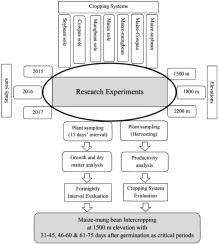European Journal of Agronomy ( IF 4.5 ) Pub Date : 2021-08-21 , DOI: 10.1016/j.eja.2021.126377 M. Arshad 1

|
Understanding temporal dynamics of growth and dry matter production of sole and intercropped maize under different agro-climatic and cultural conditions is imperative to devise crop models and optimize resources for better crop production. Field experiments comprising seven cropping systems (maize-mungbean, maize-cowpea, maize-soybean, maize sole, mungbean sole, cowpea sole, soybean sole) were performed for three years (2015, 2016 and 2017) at three elevation sites (1500, 1800 and 2200 m from mean above sea level) using factorial randomized complete block design (RCBD) with three replications. Maize growth (plant height, number of leaves, leaf area), dry matter partitioning (leaf, stem, plant) and absolute growth rate (AGR) were observed for five growth intervals (1–15, 16–30, 31–45, 46–60 and 61–75 days after germination, DAG) while yield components (thousand grain weight, grain yield, biological yield) were recorded at harvesting. Furthermore, productivity, land equivalent ratio (LER) and competition index (CR) of cropping systems computed from biomass and grain yields of maize and legumes were also compared in terms of economic and biological yields. The growth parameters, dry matter production and AGR of maize varied significantly (p ≤ 0.05) due to individual and interaction effect of year, elevation, and legume during 31–45, 46–60 and 61–75 DAG but did not vary significantly during the 1–15 and 16–30 DAG. Growth parameters, dry matter production, AGR and harvest yields of maize were the highest during 2015, at 1500 m elevation, and in intercropping with mungbean but at par with maize sole cropping. System productivity and LER were greater for maize-mungbean cropping compared to rest of the cropping systems including sole cropping. Growth parameters and dry matter production of maize were found strongly correlated (r = 0.84−0.98) with its grain and biomass yields. It is concluded that 3rd, 4th and 5th fortnightly intervals are critical periods for intercropped maize where its growth and biomass production are significantly influenced due to competition with legumes. Lower elevations and mungbean as intercrop with maize are recommended for greater economic and biological productivity of maize based intercropping systems.
中文翻译:

不同海拔的玉米单作和间作系统每两周动态和生长、干物质分配和生产力的关系
了解不同农业气候和文化条件下单作和间作玉米的生长和干物质生产的时间动态对于设计作物模型和优化资源以实现更好的作物生产至关重要。在三个海拔地点 (1500距离平均海拔 1800 和 2200 m)使用因子随机完全区组设计 (RCBD) 和三个重复。在五个生长间隔(1-15、16-30、31-45发芽后 46-60 天和 61-75 天,DAG),而在收获时记录产量成分(千粒重、粮食产量、生物产量)。此外,还在经济和生物产量方面比较了从玉米和豆类的生物量和谷物产量计算的耕作系统的生产力、土地当量比 (LER) 和竞争指数 (CR)。在 31-45、46-60 和 61-75 DAG 期间,由于个体和年份、海拔和豆科植物的交互作用,玉米的生长参数、干物质产量和 AGR 变化显着(p ≤ 0.05),但在 DAG 期间没有显着变化1-15 和 16-30 DAG。玉米的生长参数、干物质产量、AGR 和收获产量在 2015 年最高,海拔 1500 m,与绿豆间作但与玉米单作相当。与其他种植系统(包括单一种植)相比,玉米-绿豆种植的系统生产力和 LER 更高。发现玉米的生长参数和干物质产量与其谷物和生物量产量密切相关 (r = 0.84-0.98)。得出的结论是,每两周一次的第 3、4 和 5 次间隔是间作玉米的关键时期,由于与豆类的竞争,玉米的生长和生物量产量受到显着影响。为了提高基于玉米的间作系统的经济和生物生产力,建议使用低海拔地区和绿豆作为玉米间作。得出的结论是,每两周一次的第 3、4 和 5 次间隔是间作玉米的关键时期,由于与豆类的竞争,玉米的生长和生物量产量受到显着影响。为了提高基于玉米的间作系统的经济和生物生产力,建议使用低海拔地区和绿豆作为玉米间作。得出的结论是,每两周一次的第 3、4 和 5 次间隔是间作玉米的关键时期,由于与豆类的竞争,玉米的生长和生物量产量受到显着影响。为了提高基于玉米的间作系统的经济和生物生产力,建议使用低海拔地区和绿豆作为玉米间作。











































 京公网安备 11010802027423号
京公网安备 11010802027423号